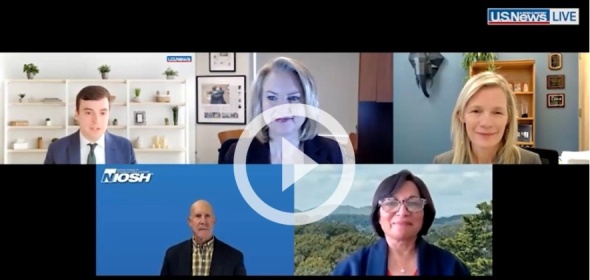By Brianna Navarre. Reprinted with permission from US News and World Report.
Pictured clockwise from top left: moderator Michael Morella, managing editor, U.S. News & World Report; Heather Farley, chief wellness officer, ChristianaCare; Lotte Dyrbye, chief well-being officer, University of Colorado School of Medicine; Sunita Mutha, Director, Healthforce Center at UCSF; and John Howard, director, National Institute for Occupational Safety and Health.
The mental health crisis among health care workers is considerable – and growing – and addressing it requires a comprehensive approach.
Some 46% of health care workers reported experiencing burnout in 2022, according to a recent report released by the Centers of Disease Control and Prevention, up from 32% in 2018. Some estimates have even placed the cost of burnout to the US health system at $4.6 billion annually.
While rates of burnout in health care trended downward prior to the COVID-19 pandemic, the last few years have resulted in dramatic increases, experts noted during a recent webinar hosted by US News & World Report.
At the start of the webinar, Senator Tim Kaine of Virginia acknowledged “the mental health toll, that death and loss at such a massive scale has visited upon the entire global population – but particularly upon the front-line health care providers who had to do so very much.”
Kaine and others have advocated for legislative action, such as the Dr. Lorna Breen Health Care Provider Protection Act, which was signed into law last March by President Joe Biden and provides financial and other support for mental health education and treatment for health care professionals.
While federal legislation is a good start, it is only one piece of the puzzle that is overcoming burnout in health care, experts said, with employers and health systems themselves needing to lead the way to provide systematic and sustained support within the workplace. The World Health Organization defines burnout as “a syndrome conceptualized as resulting from chronic workplace stress that has not been successfully managed.”
“Core to really addressing the issue of health care worker burnout is leadership commitment,” said Dr. Lotte Dyrbye, chief well-being officer at the University of Colorado School of Medicine. “You can't deliver on your mission if your most mission-critical assets – your health care workers – are suffering from high degrees of burnout.”
Indeed, the stakes are high from an operational, financial and safety standpoint, panelists noted. “We know that doctors who are burnt out are more likely to commit major medical errors,” Dyrbye said. “The level of burnout in nurses and doctors in the ICU is an independent predictor of patients dying. Whether or not you get an infection when you're in the hospital is related to whether or not your nurse is burnt out.”
In some cases, burnout potentially pushes practitioners out of medicine altogether. And the problem ranges across virtually all health professions.
“Pick a category of worker,” and there’s likely a shortage, causing “huge cascading impacts” in care, said Dr. Sunita Mutha, the director of Healthforce Center at the University of California San Francisco. Healthforce Center has expanded its focus to a commonly overlooked subset of health care workers, middle-skilled workers, such as medical and nursing assistants or food service technicians. For example, “we found that up to 40% of the staff reported some food insecurity,” she said, which often results in higher stress levels and absenteeism.
Read the rest of the article and watch the webinar replay on the US News and World Report website.
Related Content
- Advancing Health Worker Well-Being: Trends and Opportunities, Healthforce Center at UCSF
- CDC’s National Institute for Occupational Safety and Health Launches First Federal Campaign for Hospitals to Tackle Healthcare Workers Burnout, launched 10/31/2023
- Addressing Health Worker Burnout: A US Surgeon General Priority
- Taking Action Against Clinician Burnout: A Systems Approach to Professional Well-Being, National Academy of Medicine
